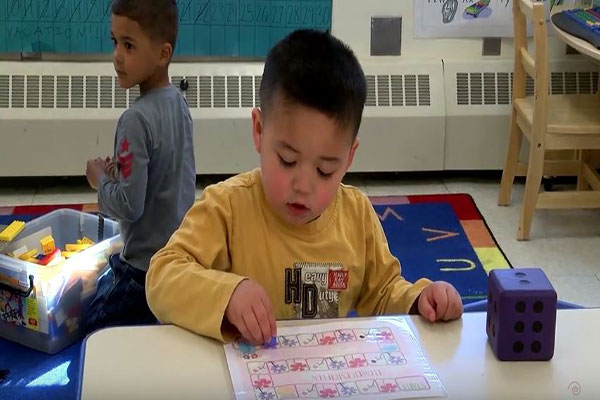Video Transcript for One-to-One Correspondence
Narrator: One to one correspondence is the ability to match one object to another object. Toddlers often demonstrate this skill when they pair things up while playing or getting dressed. For older children, one-to-one also includes the ability to match each object to a corresponding number while counting.
Child: Four, five, six.
Dr. Sudha Swaminathan, Eastern Connecticut State University: As children get more and more comfortable with rote counting, and counting out objects, they develop this idea that for every number word, they have to relate to one object. And one-to-one correspondence relates to this basic sense.
Child: One, two, three.
Dr. Sudha Swaminathan: So, you see that when children start to use fingers to keep track of their counting, or when they’re using number words to count out the children in their classroom. As they get more comfortable with counting, sometimes children recite the number words faster than they relate to the objects. So there is a discrepancy between the items and the number words. And that’s when you see that there is no one-to-one correspondence. And as children get the idea that they have to relate to just one object for each number word, they almost slow down, and they’re more purposeful.
Child: Three, four, five.
How Do You Support One-to-One Correspondence? (1:48)
Narrator: One way to support the development of this skill is by providing collections of things to manipulate and count.
Integrating Math Learning in Play (1:59)
Narrator: Games that require players to move their pieces around a board provide another enjoyable way for children to practice this mathematical skill.
Ashley Anderson, Preschool Teacher, EASTCONN – Plainfield Head Start: Scaffolding their abilities and helping them, even if it’s with one hand over hand, you know, counting “One, two…” and having them count with you. Having the other children around to help them count so that they’re getting that repetition and that support from their peers.
Child: One, two, three, four, five, six, seven, eight, nine…
Child 2: No you passed six!
Supporting Math During Routines (2:34)
Narrator: Engaging children in daily tasks provides natural opportunities to have them practice one-to-one correspondence.
Teacher: Here Gabby, (child puts plate on napkin) you’ve got two more plates.
Explicitly Teaching Math Concepts (2:53)
Narrator: You can also model strategies that children can use to help keep track of objects as they count.
Children: One, two, three, four, five.
Dr. Sudha Swaminathan: One to one correspondence provides a strong foundation for many other counting competencies that children develop later on. You can support children’s development of this critical skill by intentionally providing opportunities for young children to engage in one-to-one correspondence during their daily activities.
© 2016 Connecticut Office of Early Childhood
Produced by the Center for Early Childhood Education at Eastern Connecticut State University.
May be reprinted for educational purposes.



